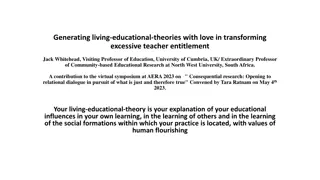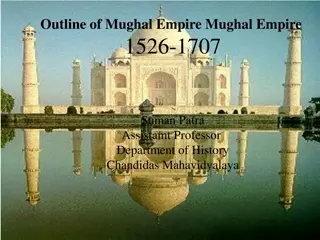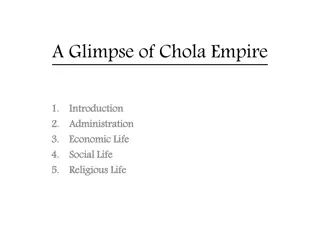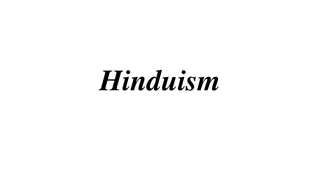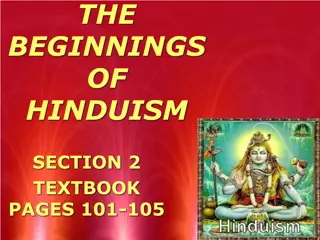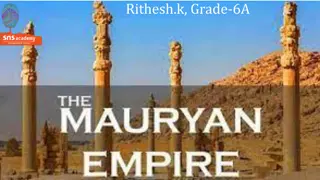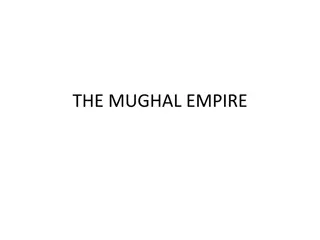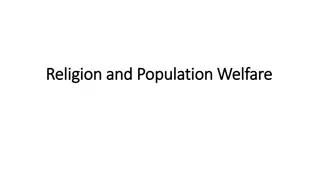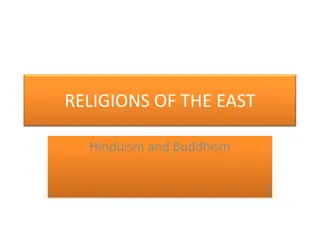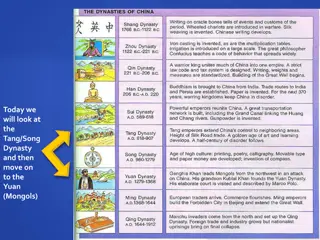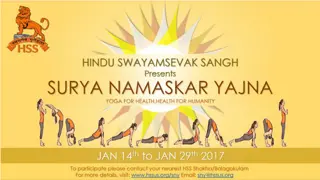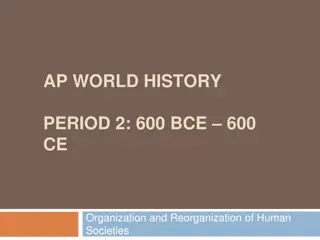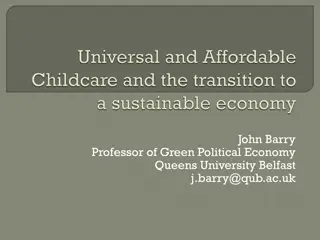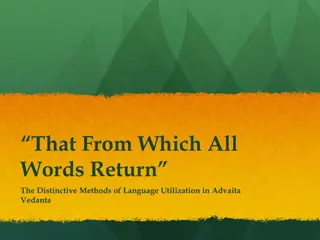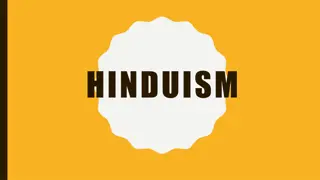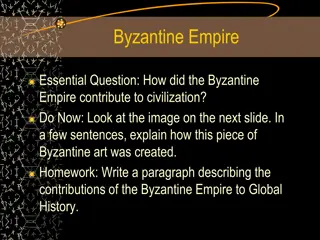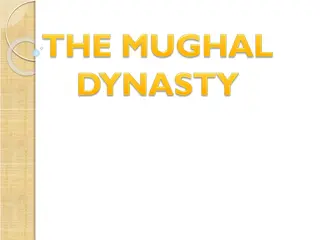Hinduism Flourishing in the Pandyan Empire
Hinduism flourished during the period of the Pandyan Empire, with rulers giving extensive donations to Saiva and Vaishnava temples. They provided endowments for temple renovation and maintenance. Notable rulers like Maravarman Sundara Pandyan and Jatavarman Sundara Pandiya contributed significantly to religious pursuits and temple construction. Religious rulers like Jatavarman Vira Pandya and Maravarman Kulasekhara made temples tax-free and made significant donations. Queens also played a role in religious contributions. Saivism and Saiva Siddhanta gained prominence during this time, with texts like Tirumular's Tirumandiram and Meykndar's Sivagnana Bhodham highlighting the philosophy. Temples were adorned with gold and new structures were added, showcasing the empire's devotion to Hinduism.
Download Presentation

Please find below an Image/Link to download the presentation.
The content on the website is provided AS IS for your information and personal use only. It may not be sold, licensed, or shared on other websites without obtaining consent from the author. Download presentation by click this link. If you encounter any issues during the download, it is possible that the publisher has removed the file from their server.
E N D
Presentation Transcript
Hinduism flourished during the period of Pandyan Empire. The rulers extensively gave donation to both Saiva and Vaihnava temple. For renovation and maintenace of the temples,they provided endowments.
Maravarman Sundara Pandyan 1stconstructed the temple Tirumattukkaraianda Nayanar at perichchikoil in about 1230 AD. Maravarman Sundara Pandya 2nddevoted himself to peaceful religious pursuits,and donated devadana village to many temples. Maravarman Vikrama pandya levied a tulabara tax(Abhisheka kanikai) to facitate the performance of the tulabara.
Jatavarman Sundara Pandiya 1stwas the most illustrious ruler of the Secoud Pandya Empire. He acuried much wealth which he used for benefaction to both siva and vishnu. He visited the Chidambaram temple and performed tulabara. With that gold he gilded the roof of the temple and established a golden hall. He earned the title Koyil Ponveynda Perumal
The Koyilolgu of the srirangam temple records a fantastic tulabara ceremony of him. With that gold,he covered the central shrine of the srirangam temple.The inner wall of that shirne was also covered with gold. Several new structures were added to tempes besides carrying out repairs. The western gopura in Chidambaram temple and the eastern gopura of Madurai Meenakshi Amman Temple were constructed by him.
Jatavarman Vira Pandya,religious ruler,made several temples free of land-tax Many sandisand fastivels were arranged for him. The last great ruler Maravarman Kulasekhara 1st was also noted for his religious benefactions. He gave donation to many temples and constructed a gopura in the Piranmalai Hill temple. He constructed the Tiuchchrrumaligai of Tirunelveli temple.
Queens also contribut to religions and in 1283 AD Ulgamuludayal,queen of Vikrama Pandya make arrangement for the conduct of rituals at Tiruvanamalai temple by har donation. Saivism: Around 12thcentury Saiva Siddthantha gained prominence. Tirumular s Tirumandiram contains the basic of Saiva Siddhanta.
Meykndar of the 13thcentury by his work called Sivagnana Bhodham has given a vivid account about Saiva Siddhanta. The Saiva Sddthanta philosophy has largely bassed on the 28 agamas. It sees to determine the relation between God,Matter and soul. It stresses the importance of Bhakti in preference to rituals and ceremonies.
The records of Maravarman Sundara Pandya 1stmention the donations given to saiva mutts. The Madurai mutt, Tiruvarur mutt, Tirunelveli Alagiya Nayanar Santhanam mutt, Bhatta Veera Santhanam mutt, Vighakauda Deva Santhanam mutt were popular mutt of the period.
During this period vaishnavism also flourished. Maravarman Sundara Pandya 1stbuilt Gnanasamuda Mandapam in the Tiruppavai Vishnu Temple. Jadavarman Sundara Pandya 1stbenefaction to the Srirangam temple amountimg to the tune of eighteen lakhs of gold pieces. He constructed theAlagarkoil perumal Tirumandapam,srirangam cheranin venran mandapam,Tulabara mandapam.
During this period, the Vaishnava Acharyas and mutt played an important role for the spread Vaishnavam. Tiruvoymoli Pillai constricted a temple for Ramamuja. The Brahmins at a place called Ramanuja Chatturvedi mangalam. Manavala Mamunigai was the last acharya and he wrote work called Upadesa Rathina Malai.He supported the Tenkalai Vaishnava sect.
The Vaishnava mutt spearheaded the spread of Vaishnavism. The Ahobila mutt and Vanamamalai mutt were prominent mutts. Other mutts: The Kulasekara mutt un Alagarkoil, The Amlala Tadam mutt in Tirunagar, The Tirumangai Mannar mutt in Tirukkurankudi
All the pandyan emperors were Saivites, but they donated lavishly to both saiva ad vaishnava temple. They gave orders of grants to other religious sects were excluded. That shows the broad religious outlook of the Pandyan rulers.
Buddhism was not popular those days. A Buddhist hailing from the Pandya country in the time of Maravarman Kulasekharaa 1stattained eminence. He presided the Buddhist conference. Jainism: Jainism had a little more importance than Buddhism. The Mangadu inscription of Jatavarma Sundra pandya 1strefers to gift of land and pallichandam to certain pallis.
Sundara pandya pudukkottai inscription mention Dharmadeva Acharya as disciple of Kanakachandrapandita. They may be two jain Acharyas of the time. The role of temples: Templess that played a significant role in the people was the centre of popular education. Religious festivals refreshed the people with popular entertainment.
The temple fortered art and culture,and temple was an economic institution by itsself,and bank. The wealth of South Indian temple: The temples of that country were full of gold and precious gems . Dance and drama were regular features of the temple particularly on fastival occasions. Thus the temple were centres of learning and fine arts.
The chittiai fastival,Tiruvadirai,Markali and Masi Tirunal were in vogue. Irrespective of flood and drought,temple services went on unintrerripted. Conclusion: Religious toleration prevailed and the heratic religions lost their importance. The Hinduism seen in the days of chola was absent in the days of the pandyas Large number of donation bestowed on religion and temples


